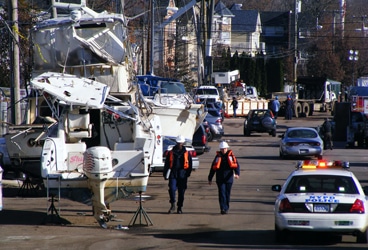
Post-Sandy Staten Island clean-up
A month after Hurricane Sandy swept the U.S. Eastern seaboard with her vicious storm surge and winds, Great Kills Harbor, Staten Island, New York, is still marked indelibly by her passing. (View the Superstorm Sandy—One Month Later photo gallery)
Sailboats and motor yachts alike stand brokenly forlorn, lines and sails draped indiscriminately over their grimy, gouged decks and hulls. Only today, the attractive sloop Deliverance was finally spared the ignominy of lying bow down toward the asphalt, stern in the air, held only by the tree she tangled with during Sandy, and which stopped her being carried onto power lines.
Insurance claim assessors, boat workers, and U.S. Coast Guard officials wander about the stacked boats, clipboards in hand. Anxious boat owners clamber from jumble of hulls to ordered lines of yachts on stands, looking for their beloved vessels.
Owners wanting to winterize their boats as the bitter winds and sleety snow move in have to find generators with which to power their endeavors. Some homeowners are still without electricity, their belongings strewn in front of their homes from flooded first-floor rooms and basement garages. Small boats lie abandoned against their fences where Sandy’s rage threw them indiscriminately.
When the Red Cross Disaster Relief Van sounds its horn, hungry people appear from their cold and powerless homes and boatyards, looking for the welcome hot meal that’s provided free of charge. The NYPD patrol day and night, spotlighting the street to deter looting and vandalism on this distressed and distressing area. During the day the area is bustling with workers piling debris from wrecked homes, marina offices, workshops, and boats into massive piles, which sanitation trucks remove each night.
“Well, I guess I’m going to have to add a couple of chapters to my book about the restoration of the cat boat,” says Andy Bogaart wryly. Andy, specializing in the restoration of wooden yachts, had all but finished his fine work on this historic sailboat. The owner requested that she be launched to enjoy a few days of fall sailing before being winterized. She was swept up in Sandy’s fury, and finished up sandwiched between two other yachts against power lines. Heartbreaking as it will be to repeat some of the restoration work, the owner has more serious problems: His home invited Sandy in through the front door, and out of the back, swamping home and vehicle. Andy’s own sailboat, Second Chance, a Hunter 42, survived on the hard, but with hull and topsides damaged from other yachts that were thrown against it by the storm.
The marinas are gradually working through the chaos in their yards. Mansion Marina’s facility illuminates the problems: on one side of the yard, retrieved sailboats stand in orderly lines; on the other, powerboats and sailboats still lie as Sandy left them, in a jumble of hulls. Recovery of sunken sailboats, motor yachts, fishing boats, trailers and docks is being carried out from crane barges and marina workboats. Now the most distressing cases are being revealed as they are lifted from the depths of the harbor, and left on stands to allow mud and seawater to drain.
“We plan to have our docks running by April” were the defiant words of Bianca Formica of Atlantis Marina. Our sailboat, Folly, was one of the vessels at Atlantis’ floating docks, which at the height of the storm surge came to rest two boatyards farther down the harbor, at Staten Island Yacht Sales, with Folly and a 40-foot motor yacht still secured to them.
“Some of the retrieval outfits here don’t know what they’re doing—one has just dropped a boat which shifted due to the seawater inside, breaking the slings: they haven’t a clue, they are writing off boats that could have been salvaged,” said a crane-boat operator. Yet, few boats are being deemed a complete loss by the insurance companies; we’ve been told that around 95 percent are recoverable.
Local businesses will long be affected by Sandy: Two of the three local bait-and-tackle stores aren’t going to re-open. There aren’t enough boats still on the water to need fishing supplies. The local marine-supplies stores are by the water, and were therefore flooded, so all the needs for repair and restoration have to come from off the island. Some harbor restaurants are starting to operate in a limited manner; others may never recover.
No one that we know of was killed, or died, on their boat. Most boat owners were in their homes, or had taken refuge on land, as did we, but one owner spoke of wading ashore, chest high in seawater, when, at the height of the storm, he realized that he was dangerously at risk onboard. His small Sparkman & Stephens yacht was later recovered from ashore, pretty much unscathed, although his home, a few blocks south, was lost to the waters.
Despite the devastated appearance of this hard-hit area, there is hope, and relief that the destruction wasn’t worse. For some boat owners, the initial shock and anxiety have been replaced by a resigned acknowledgement that this winter’s snow and bitter temperatures will prevent them working on their boat. The summer of 2013 will be a bittersweet one, of non-sailing, while they make a laborious recovery of their vessel.







